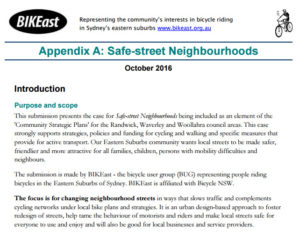“Neighbourhood streets play a vital role in making places liveable. Rather than seeing them as simply transport corridors for cars, they are important places for walking, cycling, social interactions and even playful exploration by local children.
Safe Street Neighbourhoods argues that neighbourhood streets provide a valuable focus for a road safety intervention that is low cost and yet promises considerable benefits for road safety, neighbourhood amenity, public health and the community at large.”
Journal of the Australian College of Road Safety – Volume 28 No. 3, 2017
The focus of Safe Street Neighbourhoods is for changing neighbourhood streets in ways that slows traffic and complements cycling networks under local bike plans and strategies.
It is an urban design-based approach to foster redesign of streets, help tame the behaviour of motorists and riders, and make local streets safe for everyone to use and enjoy, whilst also being good for local businesses and service providers.
Aim & objectives
- Make neighbourhood streets safe for all to use and enjoy.
- Design or re-design local neighbourhood streets to:
- make all vulnerable users safe by introducing 30km/h speed zoning
- primarily serve residential needs while maintaining essential vehicular access
- further improve amenity through adaptations that serve people’s use and enjoyment
- make every street a cycle street, for a connected neighbourhood and city.

Full document: BIKEast Safe-Streets Neighbourhoods
Also, see also Bicycle NSW – Advocacy Essentials for the model for individual advocates.
Safe-Street Neighbourhoods: the role of lower speed limits
BIKEast’s Adrian Boss collaborated with Dick van den Dool and Paul Tranter, publishing in the Journal of the Australian College of Road Safety – Volume 28 No. 3, 2017
Key Findings
- 30 km/h speed limits on local residential streets have the potential to reduce the Australian national road toll by 13% or $3.5 Billion every year.
- For example, the WA Safe Active Streets program receives bilateral political support from successive governments.
- Community fears about impacts on travel time are a political reality but technically unfounded.
- Safe-Street Neighbourhoods require strong leadership – political champions and well-trained street designers.
- The Federal Blackspot program can be readily extended to accommodate Safe Active Street and Safe-Street Neighbourhood initiatives.
